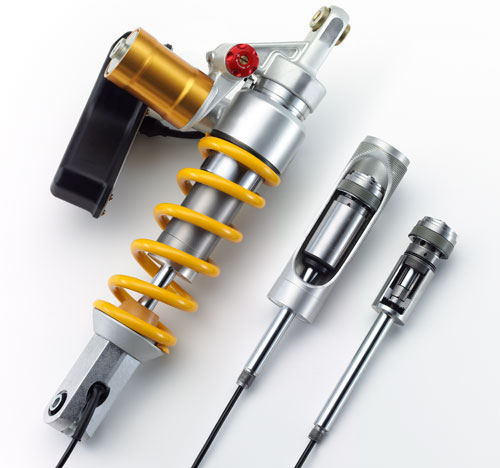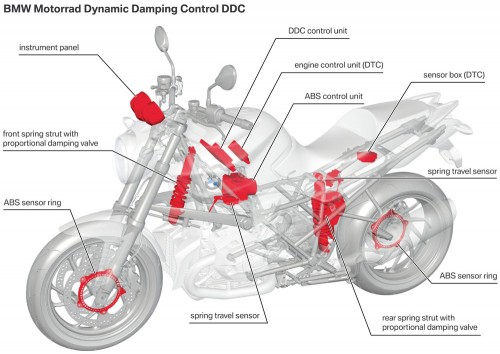BMW has rolled out dynamic damper control across nearly all their new cars recently, and now BMW Motorrad is doing the same with their bikes.
Motorrad’s DDC is a semiactive suspension system which reacts automatically to manoeuvres like braking, accelerating, and cornering on various road surfaces and analyses the situational parameters provided by sensors to set the correct level of damping at electrically actuated damping valves.

DDC is linked to the DTC and ABS systems. The system recognises the control activities by the other systems and adapts the damping as the situation requires. The adjustments to damping depend on whether the springs are compressing or rebounding, with each process being controlled separately.
Look after the jump for a full explanation on how the DDC system works.
A number of examples quickly provide some insights into the advantages for certain riding situations. Before the rider sets off, activating the ignition first initiates the system check and the flow of information from the engine control, ABS control unit, sensor box (DTC), and the spring travel sensors to the DDC control unit. This appears on the display in the instrument panel.
When the motorcycle sets off, the valves in the front and rear dampers are actuated only marginally (supplied with power) when the speed exceeds a definable value. When the rider accelerates, e.g. when leaving the city limits, the valve in the rear strut is actuated more strongly owing to the changes in dynamic wheel load distribution and in the drive torque. Once the target speed has been reached, valve actuation drops back to its original level (less power supply than setting off). Information flows from the throttle grip via engine control to the DDC control unit, and from there to the damping valves.
When the rider takes a series of corners, both damping valves are actuated more strongly with increasing inclination – starting from the low power supply – until the vertex is reached. When the vehicle returns upright between two corners, the actuation of the two damping valves constantly drops to the original power level with decreasing inclination. When the motorcycle turns into the second corner, valve actuation again rises proportionally to the angle of inclination and again drops from the vertex value. Information flows from the sensor box (DTC) to the DDC control unit, and from there to the damping valves.
When the motorcycle brakes, e.g. at a rail crossing, the actuation of the front damping valve increases proportionally to the deceleration so that the damping forces and therefore riding stability increase as a result. In this case, ?Dynamic Damping Control DDC analyses both the dynamic phase of braking, until constant deceleration and wheel load distribution, and the subsequent static phase.
Once the adjusted speed has been reached (here for passing over the rail crossing), the power supply and therefore the actuation return to their original values. At the same time, information flows from the hand brake pump on the handlebar to the ABS, and from there via the DDC control unit to the valves.
When the motorcycle is passing over the rail crossing (here representing all types of uneven road surfaces), the valves in the front and rear dampers are actuated (powered) proportionally to the respective compression travel. In this case, information flows the front and rear spring travel sensors via the DDC control unit to the valves.
When the motorcycle is finally brought to a stop, the valves are first actuated as in the braking process described above. As soon as the motorcycle is stationary, the power to the valves and therefore their actuation are deactivated.











nice ride
wonder how it is to ride??..any1 wf exp riding wif the DDC or other active suspension on bikes..pls drop a line..im reli interested to noe what its like?
They need a smaller more powerful engine and a DSG or Cvt. Ford is leading the way with a production fiesta in 1.0L ecoboost (turbo engine) with the 120hp (1.6L engine power). Its a long way to go…
Lets show our restraint and see what 2015 holds and whether the government will comply to AFTA, its just 3 years away but the change in landscape will make a lot of people stuck with the current purchase and unable to trade up or trade in unless the loan has been paid in full.
For now be patient and wait… You don't want to take a 100K loan on a 150K car only to get it wiped out in three years and less. I might as well buy a new sub 90K car now but on a 4-5 year loan. That's just sensible advise.